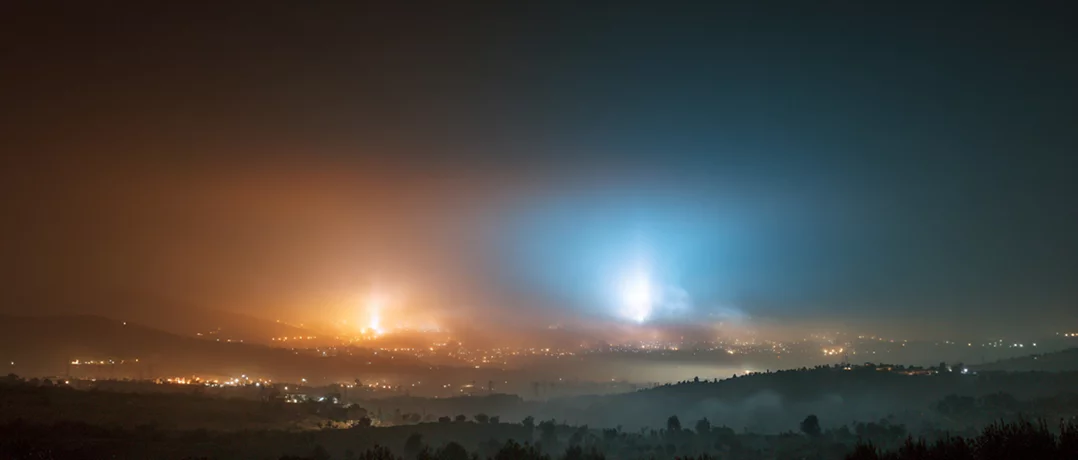Israel’s recent airstrikes in southern Lebanon have heightened fears of a potential escalation toward renewed conflict between Israel and Hezbollah amid unresolved regional tensions.
Is an Israeli war looming in Lebanon?

Israel has raised the level of its military escalation, igniting the southern front which witnessed a night of fear amid intense and heavy air raids. The strikes formed a fiery belt between the towns of Zrariyeh and Ansar, followed by a series of additional raids in the area between Ansar and Sinnay. The echoes of these explosions were heard as far as the city of Sidon and its suburbs. Earlier, Israeli drones had targeted the outskirts of Nabatieh and the area between Namiriyeh and Kouthariyet al-Sayyad, before the strikes extended toward northern Beqaa, hitting the town of Shmistar.
This new wave of air raids raises three key observations:
First: Israel is progressively pulling South Lebanon back into a “war atmosphere,” undermining the relative calm and stability that had allowed a modest social and economic recovery. This escalation places Hezbollah before a real challenge, as it remains unable to break the current stalemate or reestablish its deterrence framework. The main challenge facing the party today is no longer limited to the wounds or aftermath of the last war, it lies in a deeper battle: redefining Hezbollah’s position domestically and regionally and rebuilding its deterrent capacity. Israel, meanwhile, continues to exploit its freedom of movement to conduct targeted strikes whenever and wherever it wishes. Hezbollah does not appear close to imposing new facts on the ground or setting a deadline for ending these ongoing attacks and assassinations.
Second: Israel has recently changed its pattern of targeting and assassinations. Its operations are no longer limited to “Hezbollah members and cadres” but now focus on everything linked to reconstruction efforts. The message is clear: no reconstruction before Hezbollah’s military dismantling, which Israel sees as essential for its own security.
Israel announced yesterday that it had targeted a quarry used by Hezbollah to produce cement for rebuilding destroyed facilities and infrastructure. A few days earlier, it struck a large cluster of heavy machinery in Msayleh used for excavation and debris removal. Previously, it had assassinated engineers working on the ground in the border region, preparing for reconstruction. More recently, Israeli drones broadcast direct threats naming engineer Tarek Mazraani, urging locals to avoid him.
The reconstruction file poses a social, political, and strategic test for Hezbollah. Any blockade or pressure targeting its social base aims to turn public suffering into a tool of coercion, undermining the party’s legitimacy and its ability to preserve internal cohesion and resilience.
Third: Despite the war’s end in Gaza, Israel has not ended its war in Lebanon. It continues with new forms of conflict, short of a full-scale war, but through painful, calculated strikes. Israel seeks “negotiations under fire,” aiming to subject Hezbollah to its conditions, similar to how it reached an understanding with Hamas in Gaza.
The paradox is that while Hezbollah once linked the Gaza and Lebanon fronts through its “support war,” Hamas, like Israel, no longer views them as connected. Hezbollah paid a heavy price twice: first, by entering a war it did not time or control; second, when Hamas unilaterally exited the war at a moment ill-suited for Hezbollah. Hamas’s acceptance of the “Trump Plan” effectively marked the end of a losing war, a detachment from Iranian control, and a submission to Israel’s terms. Israel now seeks to replicate the Gaza scenario in Lebanon, reaching a tougher agreement after another round of conflict if Hezbollah fails to comply with the initial “October 28 Agreement.”
Lebanon between war and negotiation
Lebanon has effectively entered a critical race between two paths:
War, for which Israel is preparing the ground, timing, and justification once the Gaza file is closed.
Negotiations, which Lebanon hopes will avert such a war and break the current deadlock through diplomacy, particularly since no progress has been made on the Hezbollah arms issue.
This is where the importance of President Joseph Aoun’s initiative to pursue political negotiations with Israel emerges. Several factors led to this shift: the deadlock in dialogue with Hezbollah; the domestic paralysis and stagnation; and the changing regional landscape after the Gaza Agreement and the Sharm el-Sheikh Summit, which point toward negotiations and settlements. It was also influenced by the “American signal” and President Donald Trump’s statement before the Israeli Knesset:
We support the new Lebanese president in his plan to disarm Hezbollah and build a state living in peace with its neighbors. He is doing a very good job.
The negotiation step taken by President Aoun was viewed in Washington and Europe as positive and significant, but insufficient and in need of clarification and follow-up to ensure practical translation.
If we set aside the issue of presidential consensus and Hezbollah’s stance, the “negotiation initiative” remains bound by key conditions: that it be indirect and preceded by Israeli concessions such as withdrawal and cessation of attacks.
Trump’s message was clear and firm, urging the Lebanese president to complete the mission of disarming Hezbollah. Yet, Aoun’s move remains incomplete. Diplomatic sources describe Baabda’s position as an attempt to board the “train of peace and indirect negotiations” after Israeli withdrawal, guided by three considerations:
Withdrawal and cessation before talks: Lebanon’s demand for Israel to withdraw and stop strikes before indirect negotiations lacks U.S. support. Washington views it as a repetition of Aoun’s previous positions, whereas it expects him to break this circular pattern.
Nothing new in indirect talks: Lebanon has long been accustomed to indirect negotiations via American mediators such as Amos Hochstein, Morgan Ortagus, and Tom Barrack. Hence, this approach is not novel.
Alignment with Arab consensus: While Aoun’s call for Lebanon to join the regional peace momentum is sound in principle, it still lacks the practical steps required to achieve it.
From a U.S. perspective, what Washington expects from Lebanon and its president is the disarmament of Hezbollah and direct peace talks with Israel, without offering guarantees regarding Israeli withdrawal or an end to assassinations. However, Lebanon cannot engage in direct negotiations; it can only replicate the Amos Hochstein model, as direct talks remain a red line domestically.
President Joseph Aoun, after carefully assessing the region’s rapid transformations, reached a firm conviction that the era of open wars has ended and that negotiation, even if indirect, is the only viable path to sustainable results. He believes that wars in Lebanon, Gaza, and elsewhere have yielded no decisive outcomes. Between a war with no end and a negotiation that may yield solutions, diplomacy has become a realistic and necessary option, one supported by international, Arab, and Western actors alike.
However, as Aoun emphasizes, negotiations require a secure and stable environment. This means Israel must first withdraw from occupied Lebanese territories and halt its military operations against Lebanon. Only then can Beirut seize the current diplomatic momentum, especially if accompanied by genuine American pressure on Israel. Lebanon, he insists, does not seek war but negotiations modeled on the successful maritime border demarcation process.
These talks, for now, are not aimed at reaching a peace agreement, but at resolving outstanding disputes and avoiding a new destructive conflict.



